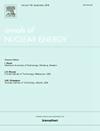核应急准备和响应管理综述
IF 1.9
3区 工程技术
Q1 NUCLEAR SCIENCE & TECHNOLOGY
引用次数: 0
摘要
在发生核或辐射紧急情况时,应急准备和反应对于保护公众健康和环境安全至关重要。本文对核与辐射应急管理的基本概念、框架和方法进行了综述。在紧急分类之前,从字面上介绍了国际原子能机构(IAEA)特别承担的组织框架、职责和倡议方案。然后详细讨论了应急规划区(EPZ)分类和应急行动级别(EALs)的一般原则,作为国家当局和国际机构在核或辐射紧急情况下需要执行的防护行动规划的基础。同时,还对放射性核素释放、运输、弥散和沉积、剂量评估所用的方法和工具进行了系统的调查和比较,为从业者在应急准备规划中的研究和设想提供指导。最后,展望了与应急准备和响应相关的主要挑战和发展趋势,以及边缘人工智能(ai驱动)解决方案的革命,以利用核和辐射应急管理中的协作感知和风险知情决策。本文章由计算机程序翻译,如有差异,请以英文原文为准。
A review on nuclear emergency preparedness and response management
Emergency preparedness and response (EPR) are essential to protect the public health and environmental safety in the event of a nuclear or radiological emergency. In the paper, the fundamental concepts, framework and methods for nuclear and radiological emergency management are reviewed from a comprehensive perspective. Prior to the emergency classifications, the organizational framework, responsibilities and initiative programs especially undertaken by the International Atomic Energy Agency (IAEA) is literally introduced. Then the generic principles for classification of emergency planning zones (EPZ) and emergency action levels (EALs) are in detail discussed as a basis for the planning of protective actions that the national authorities and international agencies need to perform during a nuclear or radiological emergency. Meanwhile, the methodologies and tools used for radionuclides release, transport, dispersion and deposition, dose assessment are also systematically investigated and compared to provide a guide for practitioner’s research and vision in emergency preparedness planning. Finally, the major challenges and development trends associated with emergency preparedness and response are prospected with the revolution of edge artificial intelligence (AI-driven) solutions to leverage collaborative perception and risk-informed decision making in nuclear and radiological emergency management.
求助全文
通过发布文献求助,成功后即可免费获取论文全文。
去求助
来源期刊

Annals of Nuclear Energy
工程技术-核科学技术
CiteScore
4.30
自引率
21.10%
发文量
632
审稿时长
7.3 months
期刊介绍:
Annals of Nuclear Energy provides an international medium for the communication of original research, ideas and developments in all areas of the field of nuclear energy science and technology. Its scope embraces nuclear fuel reserves, fuel cycles and cost, materials, processing, system and component technology (fission only), design and optimization, direct conversion of nuclear energy sources, environmental control, reactor physics, heat transfer and fluid dynamics, structural analysis, fuel management, future developments, nuclear fuel and safety, nuclear aerosol, neutron physics, computer technology (both software and hardware), risk assessment, radioactive waste disposal and reactor thermal hydraulics. Papers submitted to Annals need to demonstrate a clear link to nuclear power generation/nuclear engineering. Papers which deal with pure nuclear physics, pure health physics, imaging, or attenuation and shielding properties of concretes and various geological materials are not within the scope of the journal. Also, papers that deal with policy or economics are not within the scope of the journal.
 求助内容:
求助内容: 应助结果提醒方式:
应助结果提醒方式:


